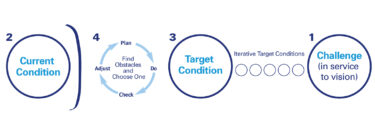Working in lean process improvement in healthcare, I wanted to find out why 40% of the Lean/Six Sigma projects in for-profit companies succeeded while only 20% succeeded in healthcare. Although for-profit or non-profit, all organizations seem to struggle.
Satya S. Chakrovorty says much of the responsibility lies with senior management who lose focus on Lean and move on to other things. This may be a part of the problem, but it is not the whole of the problem. Even when there is buy-in of senior management in the for-profit world–buy-in being espoused as the cornerstone of all successful lean initiatives–there is still that nagging 60% failure rate. In healthcare, the percentage of failed improvement efforts is even worse.
Having come from industry, this made me think back to what drives organizations to implement process improvement initiatives in the first place. And then not just implement, but continue to support process improvement throughout the organization.
What drives these organizations is what should drive all of us: how is a particular process improvement effort going to improve the bottom line for this service or product and in turn contribute to the organization’s stability and viability? We are talking about Return on Investment (ROI).
ROI feels like a foreign concept to most nonprofits, one which too many cannot or will not tie back to process improvement. Of the 10 different healthcare organizations I’ve worked with, most of which have focused on improving patient “flow,” I’ve seen little to no effort to quantify savings gained by the implementation of process improvement efforts. I’ve seen project charters and process maps with no mention of how the improvement effort they are working on is going to impact the bottom-line. Rarely is there any attempt to: 1) quantify the actual cost of the service provided or 2) quantify how much was saved by implementing an improvement. If you don’t know your cost, how can you know if what you have done has really had a positive financial impact on the organization’s bottom line? How often do you choose to improve processes that may not provide any financial benefit whatsoever?
This may be because healthcare organizations don’t think about “cost to produce” the same way for-profit corporations and manufacturing companies do. They hardly know the “true” cost of the individual services or products they provide to their patients. Very little effort is made to quantify the dollar impact all the processes listed in a value stream or process map. Healthcare leaders may be failing to acknowledge the impact of process improvement on ROI. Healthcare organizations continue to see their services as necessities that will always be available at some level despite the cost of production (a notion they might want to quickly disabuse themselves of).
Does improving patient flow mean a physician can see more patients? If s/he can, we need to look at what the financial consequences have been to the organization for seeing fewer patients and extrapolate the financial benefits. As we improve flow, we must quantify the costs of the steps along the way (I call this a Financial Process Map), look to see which steps are considered non-value added (in process flow and financial flow), and eliminate or reduce time spent on those. Once we quantify the steps we can easily see how their elimination or improvement can reduce costs.
If with Lean we spend too much time worrying about the composition of process improvement teams or creating process maps and value stream maps and not enough time finding out if the processes we seek to improve are really going to provide financial benefit to the organization, we are hamstringing our lean efforts across the board.
We cannot continue to sell the concept of lean process improvement as only that – process improvement. CEOs and CFOs of healthcare organizations want to know if Lean is going to give them a strong return on investment. Once they see the financial benefit (in addition to improved work processes), they will be more open not only to implementing Lean, but sustaining Lean.





